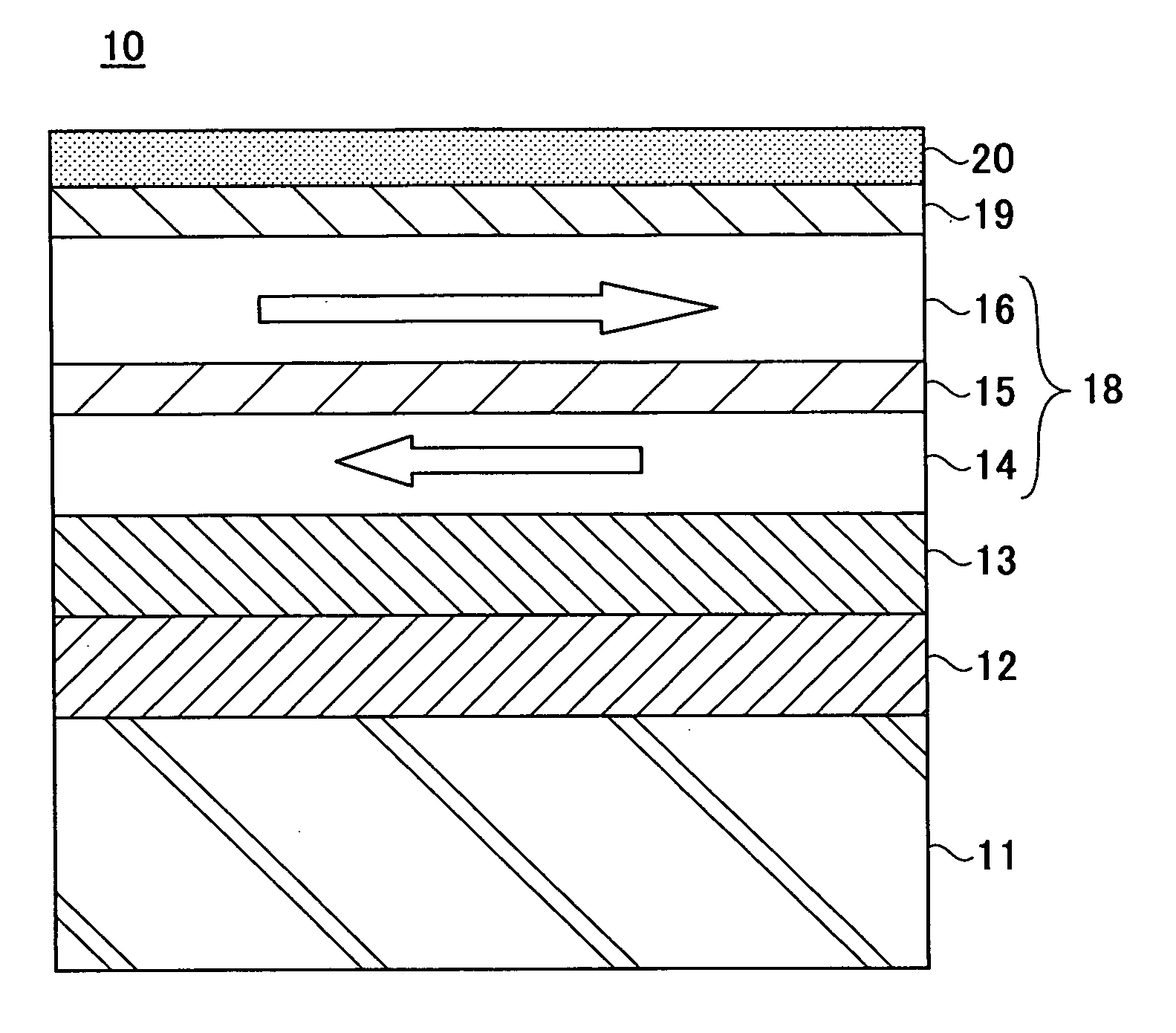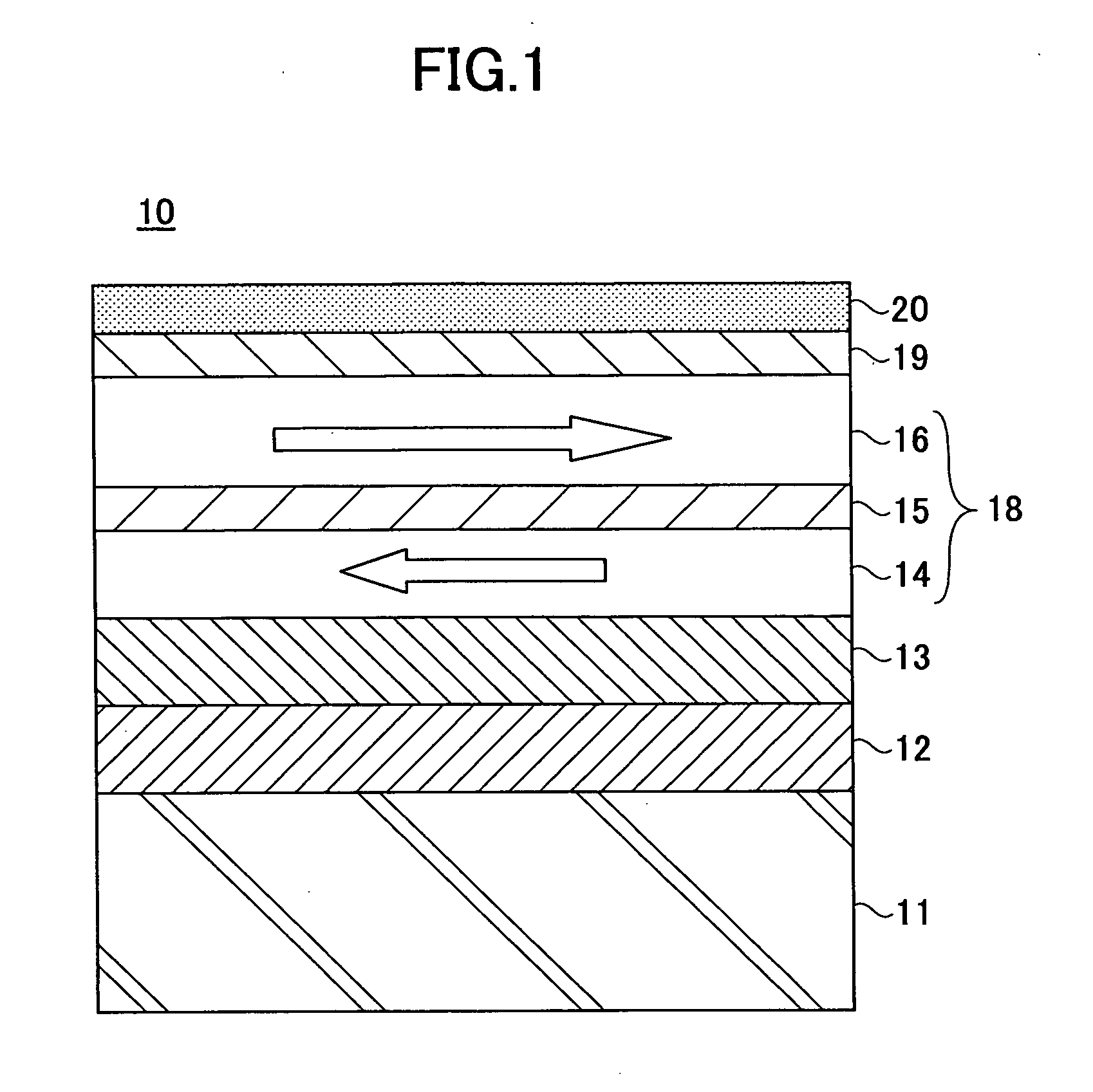Magnetic recording medium, method of producing magnetic recording medium and magnetic storage apparatus
- Summary
- Abstract
- Description
- Claims
- Application Information
AI Technical Summary
Benefits of technology
Problems solved by technology
Method used
Image
Examples
first embodiment sample emb-1
[0079] The D.C. magnetron sputtering apparatus 30 was used to form a magnetic disk having the following structure, as the magnetic recording medium 10.
[0080] The magnetic disk created includes a glass substrate 11 having a diameter of 65 mm, an AlRu seed layer 12 having a thickness of 10 nm, a Cr underlayer 13 having a thickness of 4.5 nm, a Co90Cr10 first magnetic layer 14 having a thickness of 2 nm, a Ru nonmagnetic spacer layer 15 having a thickness of 0.7 nm, a CoCrPt12B7Cu4 second magnetic layer 16 having a thickness of 15 nm, and a C protection layer 19 having a thickness of 4.5 nm.
[0081] The glass substrate 11 was heated to 180° C. within vacuum by the PBN heater prior to forming the AlRu seed layer 12. The glass substrate 11 was heated similarly to 230° C. prior to forming the Ru nonmagnetic spacer layer 15. Using the sputtering apparatus 30 shown in FIGS. 5 and 6, the erosion region 31a was formed in the AlRu sputtering target 31 between a position where the radius is 67....
second embodiment sample emb-2
[0082] Using the sputtering apparatus 30 shown in FIGS. 5 and 6, the erosion region 31a was formed in the AlRu sputtering target 31 between a position where the radius is 47.0 mm and a position where the radius is 77.0 mm from the disk center of the glass substrate 11. A center position of the erosion region 31a is located at a radius of 62.0 mm from the disk center of the glass substrate 11. The incident angle θINC of the sputtering particles from the outer peripheral side of the glass substrate 11 was set to a center incident angle of 38.7 degrees (of a range from 23.0 degrees to 49.6 degrees) at the outer (or outermost) peripheral position DOUT shown in FIG. 6, and to a center incident angle of 51.3 degrees (of a range from 41.2 degrees to 58.4 degrees) at the inner (or innermost) peripheral position DIN shown in FIG. 6. Otherwise, the second embodiment sample Emb-2 was created under the same conditions as the first embodiment sample Emb-1 described above.
third embodiment sample emb-3
[0083] Using the sputtering apparatus 30 shown in FIGS. 5 and 6, the erosion region 31a was formed in the AlRu sputtering target 31 between a position where the radius is 47.0 mm and a position where the radius is 57.0 mm from the disk center of the glass substrate 11. A center position of the erosion region 31a is located at a radius of 52.0 mm from the disk center of the glass substrate 11. The incident angle θINC of the sputtering particles from the outer peripheral side of the glass substrate 11 was set to a center incident angle of 28.8 degrees (of a range from 23.0 degrees to 34.0 degrees) at the outer (or outermost) peripheral position DOUT shown in FIG. 6, and to a center incident angle of 45.0 degrees (of a range from 41.2 degrees to 48.4 degrees) at the inner (or innermost) peripheral position DIN shown in FIG. 6. Otherwise, the third embodiment sample Emb-3 was created under the same conditions as the first embodiment sample Emb-1 described above.
PUM
 Login to View More
Login to View More Abstract
Description
Claims
Application Information
 Login to View More
Login to View More - R&D
- Intellectual Property
- Life Sciences
- Materials
- Tech Scout
- Unparalleled Data Quality
- Higher Quality Content
- 60% Fewer Hallucinations
Browse by: Latest US Patents, China's latest patents, Technical Efficacy Thesaurus, Application Domain, Technology Topic, Popular Technical Reports.
© 2025 PatSnap. All rights reserved.Legal|Privacy policy|Modern Slavery Act Transparency Statement|Sitemap|About US| Contact US: help@patsnap.com



